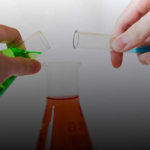Section 1
Preview this deck
Nonmetal
Front
Active users
0
All-time users
0
Favorites
0
Last updated
4 years ago
Date created
Mar 14, 2020
Cards (65)
Section 1
(50 cards)
Nonmetal
Elements that are poor conductors of heat and electric current. Most are gases, dull & brittle.
Magnetism
A property of some materials in which there is a force of repulsion or attraction between certain like and unlike poles.
Chemical Properties
Describes matter based on its ability to change into a new kind of matter with different properties.
Law of Conservation of Matter
Matter is not created nor destroyed in any chemical or physical change.
Physical Change
A change of matter from one form to another without a change in chemical properties.
Period
Horizontal row of elements in the periodic table.
Metalloid
Elements that may accept or donate electrons readily and possess a mixture of metallic and nonmetallic properties.
Neutrons
Neutral particles in the nucleus of an atom
Group
A vertical column of elements in the periodic table; elements in a group share chemical properties. Also known as a family.
Crystal
A substance in which the particles are arranged in an orderly, geometric, repeating pattern.
Ion
An atom or group of atoms that has a positive or negative charge.
Metal
A class of elements characterized by physical properties that include shininess, malleability, ductility, and conductivity.
Malleable
Easy to shape or bend by hammering usually into flat sheets.
Atomic Symbol
A one or two letter abbreviation for an element. Also known as the elemental symbol or chemical symbol.
Ductile
adj. Capable of being drawn out or easily pulled into long wires.
Matter
Anything that has mass and takes up space.
Product
A substance produced in a chemical reaction.
Semiconductor
A material that when combined with some other material can be turned into an insulator or a conductor.
Chemical Change
A change in matter that forms one or more new substances.
Homogeneous Mixture
A mixture that is uniform in composition; components are evenly distributed and not easily distinguished.
Valence Electrons
Electrons in the outermost energy level of an atom that are typically involved in chemical reactions by being gained, lost, or shared in the formation of chemical bonds.
Inert gases
Another name for the noble gases because of their stability and inability to react.
Reactant
A substance that takes part in and undergoes change during a reaction.
Subscript
A number in a chemical formula that tells the number of atoms in a molecule or the ratio of elements in a compound.
Heterogeneous Mixture
A mixture in which different materials can be distinguished easily.
Molecule
The simplest structural unit of an element or compound.
Nucleus
Center of an atom.
Chemical Reaction
In a chemical reaction, the reactants are changed into the products, which are different substances.
Chemical Formula
A combination of chemical symbols and numbers to represent a substance.
Periodic Table
Chart used to organize all known elements.
Chemical Bond
The force that holds two atoms together.
Natural Element
An element found in nature. 92 elements are considered natural elements.
Insulator
A material that does not allow heat or electrons to move through it easily.
Atomic Mass
total weight of protons and neutrons (everything in the nucleus)
Precipitate
A solid that forms from a solution during a chemical reaction.
Pure Substance
A sample of matter, either a single element or a single compound, that has definite chemical and physical properties.
Electrons
Tiny, negatively charged, high-energy particles that move around outside the nucleus of an atom
Atom
Basic unit of matter
Atomic Number
Equals the number of protons in the nucleus (never changes)
Charge
A measure of the extra positive or negative particles that an object has.
Protons
A positively charged particle in the nucleus of an atom
Physical Property
A quality or condition of a substance that can be observed or measured without changing the substance's composition.
Synthetic Element
Elements which do not occur naturally and are made in laboratories.
Reactivity
The ease and speed with which an element combines, or reacts, with other elements and compounds.
Filtration
A process that separates materials based on the size of their particles.
Conductor
A material or an object that conducts heat, electricity, light, or sound.
Chemical Equation
A representation of a chemical reaction that uses symbols to show the relationship between the reactants and the products.
Element
A pure substance made of only one kind of atom.
Coefficient
A number in front of a chemical formula in an equation that indicates how many molecules or atoms of each reactant and product are involved in a reaction.
Compound
A substance made of two or more elements chemically combined in a specific ratio, or proportion.
Section 2
(15 cards)


